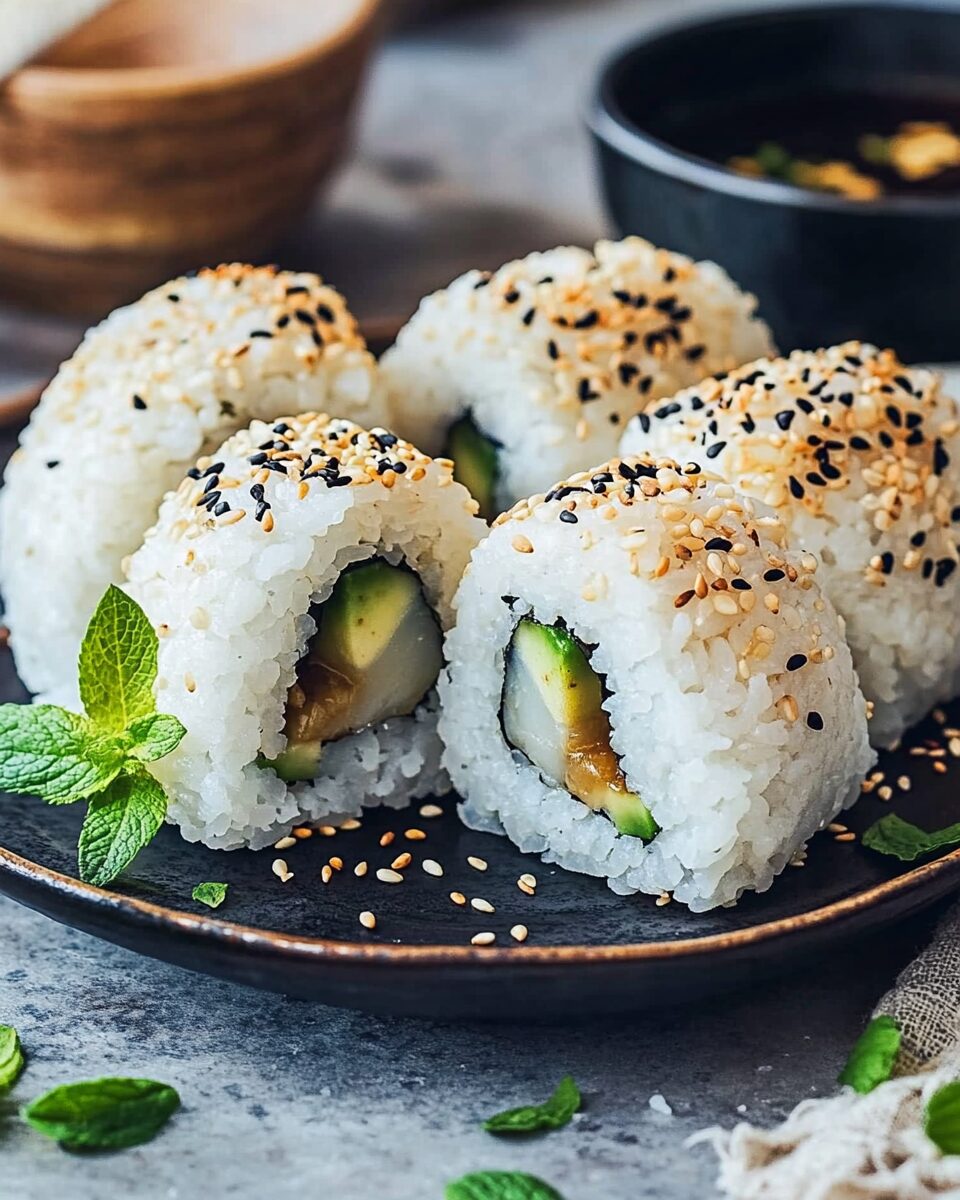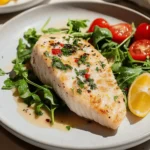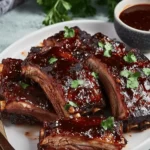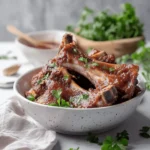These Japanese Yaki Onigiri are simple, crispy grilled rice balls stuffed with avocado and salted peanuts, coated in a tasty dumpling dipping sauce and sesame seeds.
FULL RECIPE:
Ingredients
- For the Rice Balls:
- 1½ cups (300 g) Japanese short-grain rice
- 2 cups (480 ml) water
- 2 tbsp rice vinegar
- 1 tbsp sugar
- 1 tsp salt
- 1 avocado, pitted and diced
- 2-3 tbsp salted peanuts, chopped
2. For the Coating:
- 2-3 tbsp dumpling dipping sauce (or soy sauce)
- 2-3 tbsp sesame seeds
- 1-2 tbsp sesame oil, for frying
Directions
- Cook the Rice: Rinse the rice under cold water until it runs clear. Combine the rice and water in a pot; bring to a boil. Once boiling, reduce heat to low, cover, and simmer for about 15 minutes until water is absorbed. Remove from heat and let it sit, covered, for an additional 10 minutes.
- Season the Rice: In a small bowl, mix rice vinegar, sugar, and salt until dissolved. Gently fold this mixture into the cooked rice. Allow the rice to cool slightly until it’s safe to handle.
- Form the Rice Balls: With wet hands, take about 2 tablespoons of rice and flatten it in your palm. Place a piece of avocado and some chopped peanuts in the center. Cover with another tablespoon of rice and shape into a ball, ensuring the filling is sealed inside. Repeat with the remaining ingredients.
- Pan-Fry the Rice Balls: Lightly brush each rice ball with the dumpling dipping sauce and sprinkle with sesame seeds. Heat sesame oil in a non-stick pan over medium heat. Place the rice balls in the pan, seam side down, and cook for 3-5 minutes until golden brown. Brush the tops with more dipping sauce, sprinkle with sesame seeds, flip, and cook the other side until crispy.
- Serve: Remove from the pan and serve warm with additional dipping sauce, if desired.
Nutrition Facts
- Calories: Approximately 250 kcal
- Carbohydrates: 40 g
- Protein: 5 g
- Fat: 8 g
- Saturated Fat: 1 g
- Fiber: 3 g
- Sugar: 1 g
- Sodium: 400 mg
Tips for Making the Best Yaki Onigiri
To make the best Yaki Onigiri, it is essential to use the right type of rice. Japanese short-grain rice is the best choice because it has the perfect balance of stickiness and texture to hold the rice balls together. If you use long-grain rice or other types of rice that don’t stick well, the onigiri may fall apart when shaping or frying. Cooking the rice properly is also crucial. Rinsing the rice multiple times before cooking removes excess starch, which helps improve the texture. Once cooked, letting the rice rest before shaping allows the grains to settle, making it easier to handle. Another key factor is shaping the onigiri. Wetting your hands slightly before handling the rice prevents it from sticking, making the process much smoother.
Variations and Customizations
One of the great things about Yaki Onigiri is its versatility. While the classic version is typically brushed with soy sauce and sesame seeds, there are many ways to customize the flavor and filling to suit different tastes. Some popular variations include:
- Miso Butter Yaki Onigiri: Instead of using soy sauce, a mixture of miso paste and butter can be brushed onto the rice balls. This creates a rich, umami-packed flavor that enhances the crispy texture.
- Spicy Yaki Onigiri: Adding a touch of chili oil or spicy sriracha mayo inside or on top of the rice balls gives them a bold kick. This is a great option for those who enjoy spicy food.
- Cheese-Stuffed Yaki Onigiri: Melting cheese inside the onigiri adds a creamy and savory element that pairs well with the crispy rice exterior.
- Seaweed-Wrapped Yaki Onigiri: Wrapping the grilled rice balls with nori (seaweed) not only enhances the flavor but also makes them easier to handle while eating.
- Teriyaki Glazed Yaki Onigiri: Instead of soy sauce, a sweet and savory teriyaki glaze can be brushed onto the rice balls for a delicious twist.
Serving Suggestions
Yaki Onigiri can be enjoyed on their own as a snack or light meal, but they also pair well with other Japanese dishes. Serving them with miso soup creates a comforting combination, while a side of pickled vegetables adds a refreshing contrast to the crispy rice. They can also be served alongside a Japanese-style salad with sesame dressing for a well-balanced meal. For those who enjoy dipping sauces, Yaki Onigiri can be served with additional soy sauce, ponzu sauce, or even a homemade spicy mayo. These sauces enhance the flavors and provide an extra layer of taste. Yaki Onigiri also make a great addition to bento boxes. Their sturdy shape allows them to be packed easily without falling apart, making them a convenient option for lunch on the go. They can be paired with small portions of edamame, tamagoyaki (Japanese rolled omelet), or grilled vegetables for a complete and satisfying meal.
Cultural Significance of Yaki Onigiri
Onigiri has been a staple of Japanese cuisine for centuries, dating back to the Heian period (794-1185). They were originally made as a convenient food for travelers and warriors because they were easy to carry and provided a good source of energy. While traditional onigiri is typically eaten cold, Yaki Onigiri introduced the idea of grilling the rice balls to add extra flavor and texture. In Japan, Yaki Onigiri is commonly enjoyed as a street food snack, often sold at food stalls and izakayas (Japanese pubs).
Health Benefits of Yaki Onigiri
Yaki Onigiri can be a nutritious addition to a balanced diet. The main ingredient, rice, is a great source of carbohydrates that provide energy for the body. Japanese short-grain rice is also rich in essential nutrients like B vitamins and minerals, which support overall health. When paired with healthy fillings like avocado, vegetables, or lean proteins, Yaki Onigiri becomes a well-rounded meal that includes fiber, vitamins, and protein. The sesame seeds used for coating are also a good source of healthy fats and antioxidants, which contribute to heart health. For those looking for a lower-calorie option, Yaki Onigiri can be made with brown rice instead of white rice. Brown rice contains more fiber and nutrients, making it a healthier alternative. Additionally, reducing the amount of oil used for grilling can help lower the overall calorie content of the dish.
Conclusion
Yaki Onigiri is a delicious and versatile Japanese dish that combines the simplicity of rice with bold flavors and textures. The crispy grilled exterior, combined with a warm and flavorful filling, makes it a satisfying snack or meal option. Whether enjoyed on its own, paired with traditional Japanese dishes, or customized with different fillings and seasonings, Yaki Onigiri is a dish that appeals to a wide range of tastes. Its cultural significance and history add to its charm, making it more than just a meal it’s a reflection of Japanese culinary tradition. Additionally, the dish offers a balance of nutrition, making it a great option for those looking for a wholesome yet delicious bite






